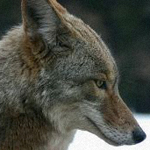Biology
- Neither are generally a threat to human health and safety.
- Coyotes occur throughout the community wherever substantial open areas remain (mountain preserves, golf courses, larger blocks of undeveloped land, etc.). Once restricted to western grasslands, they have spread to urban areas all over Canada. They have been able to fill the vacant niche left by the extirpation of other large predators (timber wolves and cougars).
- Coyotes have a varied diet including rodents, rabbits, fawns, snakes, lizards, other small wild and domestic animals, mesquite beans, fruits, vegetables, pet food, and pretty much any garbage they can find.
- Adult coyotes weigh between 20 and 30 lbs (13 kg) and measure 18-21 inches tall and 42-50 inches in length.
- The ears are usually carried more erect than a dog's, and the distinct black patches at the base and tip of the tail also help distinguish coyotes from dogs. Coyotes have dark fringes on their coat, generally grey with a rusty tint on the neck and flanks. Their tails are carried lower than a dog's.
- An average coyote litter contains 5 to 6 pups. They are born in dens that, in an urban environment, can be inside storm drains, under storage sheds, in holes dug in vacant lots, parks or golf courses, or in any other dark, dry place. They typically den where thick, dense vegetation obstructs view of the entrance and makes human entry difficult.
- Coyotes respond to persecution with a behaviour known as compensatory reproduction. When under pressure, they produce larger litters with higher survival rates. Females come into heat at a younger age than normal.
- The coyote young are fairly independent at about 1 month of age. Food requirements increase dramatically during the breeding season (winter through spring).
- Coyotes tend to travel and hunt singly or in pairs. They may form groups as population density increases or where food is abundant. Family groups remain together during the summer and into the early fall.
- Wolves normally live in packs with a strict hierarchy. They only have one litter per year. It usually contains 1-11 pups with an average of 4-7 pups.
- Wolves are more closely associated to wooded areas than coyotes. Only a desperate or inexperienced wolf will approach an object bearing the scent of people, metal and plastic.
- Wolves have a more specialized diet consisting of beavers in summer and cervids in winter. They do not like to consume small prey. Wolves are the coyotes' main natural predator.
- Wolves are generally bigger than the coyote and have more rounded ears and muzzle.
Self-Help
If the coyote or wolf is confined but can leave on its own, open a gate or door, allowing the animal to leave. Patch-up entryways in fences, gates, and foundations. If the animal continues to stay, try spraying it with a hose.
Removal of Attractants
- Do not feed or provide water for coyotes or wolves in your neighbourhood, and encourage your neighbours to refrain as well.
- Feed your pets inside, or remove uneaten pet food between feedings. Never leave pets outside unattended if coyotes or wolves frequent the area.
- Remove bird feeders. Coyotes are attracted to the birds and rodents that come to the feeders.
- Secure garbage containers and eliminate garbage odours by washing out the cans with ammonia. Coyotes will eat garbage if left accessible.
- Trim and remove any near ground-level shrubs or branches that provide hiding cover or den sites for coyotes or prey.
- Keep poultry, rabbits, and rodents in secured enclosures
Habitat Modification & Exclusion
- Fencing will deny access to coyotes and wolves in most cases, depending on the type (brick, chain link, electric) and the height of the fence. A single strand of electric fencing set at 15-18 inches above the ground is simple and cost effective. It can be powered through AC or battery. Best results are realized when the hot wire is baited with molasses smeared on a piece of tin foil.
- Close or patch-up entryways.
Repellents
Scare off with loud noises, or by spraying with water from the hose.
Self-Help Trapping
- This is not recommended.
- Coyotes are notoriously difficult to trap. Relocation is not very productive either since another coyote will probably take up the vacated spot in no time.
Problem Diagnosis
IS THERE A PROBLEM? HOMEOWNER SHOULD ACCEPT NORMAL, UNOBTRUSIVE BEHAVIOR
Refer to SELF-HELP if:
- The animal is confined but able to leave on its own.
- Anyone is deliberately or inadvertently feeding it.
- The problem is repetitive. Are the neighbours having the same problem? Has anyone seen the animal in same area before?
- Property damage has occurred (includes the taking of pets).
Refer to PROFESSIONAL ASSISTANCE if:
- The coyote or wolf is posing an immediate threat to public safety.
- The animal is injured.
- A young animal is orphaned.
- A bite has occurred.
- Homeowner is unable or unwilling to exercise self-help options.
Professional Assistance
- Humane Wildlife Control (514-395-4555)
- In the case of a bite: If a domestic pet has been bitten, bring the pet immediately to the vet. In off-hours, emergency cases can be brought to DMV, a 24-hour veterinary service. However, this clinic, though extremely thorough and knowledgeable, is also quite expensive. If a human has been bitten, bring them directly to a hospital.

